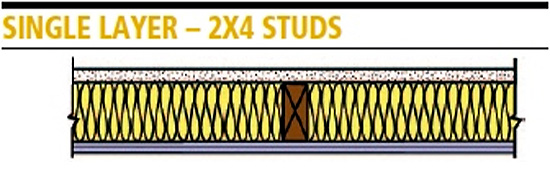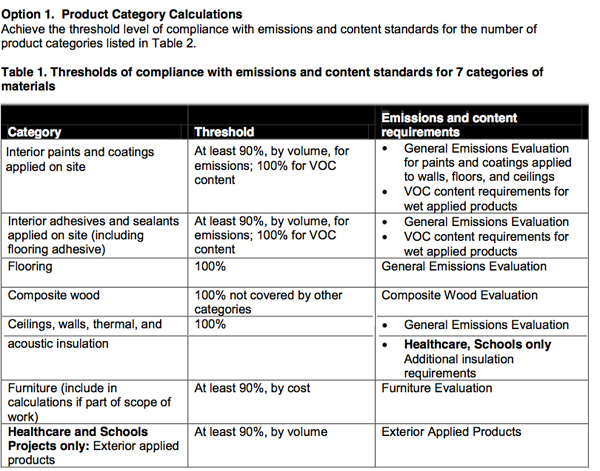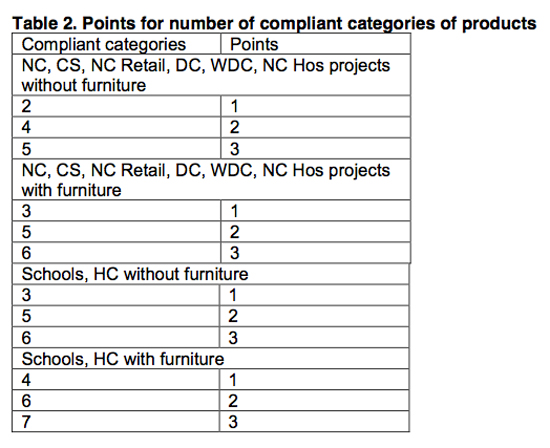Gypsum’s Role in Earning Points in LEED v4 EQ, and Other Credits
The requirements in LEED v4 for Sound Transmission indicate that the STC ratings should meet the composite STC listed in Table 1 below, or the local building code, whichever is more stringent.vii
| Adjacency combinations | STC | |
|---|---|---|
Residence (within a multifamily residency | Residence, hotel or motel room |
55 |
Residence, hotel or motel room | Common hallway, stairway |
50 |
Residence, hotel or motel room | Retail | 60 |
Retail | Retail | 50 |
Standard office | Standard office | 45 |
Executive office | Executive office | 50 |
Office, conference room | Hallway, stairway | 50 |
Mechanical equipment room | Occupied area | 60 |

Image courtesy of National Gypsum
According to calculations by a major gypsum board manufacturer, a single layer of regular ½-inch gypsum board vertically applied to each side of 2x4 studs 16-inch o.c. with 3-inch fiberglass insulation in the stud cavity produces an STC of 34.

Image courtesy of National Gypsum
However, a single layer of ½-inch sound-dampening gypsum board vertically applied to one side of 2x4 studs 16-inch o.c., with regular gypsum board on the other side, with 3-inch fiberglass insulation in the stud cavity produces an STC of 49.
STCs of up to 67 can be achieved with 5/8-inch sound-dampening gypsum, staggered studs, double studs and other strategies.
For schools, the classrooms and core learning areas must meet the STC requirements of ANSI S12.60-2010 Part 1, or a local equivalent. Plus, exterior windows must have an STC rating of at least 35, unless outdoor and indoor levels verifiably justify a lower level.
Details can be found in the reference guide.viii
Indoor Environmental Quality Credit: Low-emitting Materials (BD+C 1 - 3 points)
According to the LEED Reference Guide for Building Design and Construction, the intention of the Low-emitting Materials credit is: “To reduce concentrations of chemical contaminants that can damage air quality, human health, productivity, and the environment.”ix
And that is the exact recommendation from UL (Underwriters Laboratories), the parent company of the GREENGUARD certification system, for improved air quality: chemical source control. This is a very different intention from newly introduced interior sheathing products that purport to scavenge pollutants from the air and store them inside the wall. The long-term implications for such scavenger technologies are not yet evident.
Natural and byproduct gypsum drywall have natural “sink” properties that work in unison with the natural ebb and flow and heat and moisture inside buildings, a system that has proven healthy and reliable for many decades.
The requirements for the credit include directives for product manufacturing as well as for project teams, covering the volatile organic compound (VOC) content of materials, as well as VOC emissions into the indoor air. The interior and exterior of the building are divided into seven categories, each with differing thresholds of compliance.
The building interior is defined as everything within the waterproofing membrane, including the gypsum sheathing. The building exterior is defined as everything outside and inclusive of the primary and secondary weatherproofing system, such as waterproofing membranes and air- and water-resistive barrier materials.
From LEED 2009 to LEED v4, this credit has changed considerably. Three separate credits from LEED 2009 have been combined into one, and the credit for no added urea-formaldehyde in some materials has been eliminated.
Now, all indoor materials have to be tested by manufacturers for VOC emissions over a period of time, while paints and adhesives, referred to as wet-applied materials, must be tested for VOC content (what’s actually in the can) as well as for emissions.
These materials must meet VOC emission criteria set by the stringent California Department of Public Health (CDPH) Standard Method v1.1–2010. By referencing CDPH v1.1-2010, commonly known as California 01350, LEED v4 is setting a high standard. Programs that use the CDPH standard for testing include GREENGUARD, Green Label Plus and FloorScore®.
There are two options for compliance. Option 1 is “Product Category Calculations.”x

Source: LEED Reference Guide for Building Design and Construction
Option 1 Product Category Calculations

Source: LEED Reference Guide for Building Design and Construction
Table 2 Points for Number of Compliant Categories









